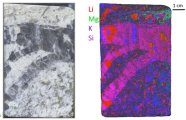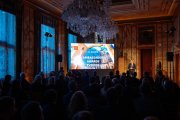News
Success of the Real Paleontologist’s Handbook
The new popular-science book "Real Paleontologist’s Handbook" by Lukáš Laibl has been included in the Best Books for Children catalogue this year. This annual selection of noteworthy Czech titles for children and young readers is prepared by the Association of Czech Booksellers and Publishers in cooperation with the Czech Section of the International Board on Books for Young People. The catalogue serves as a guide for booksellers, libraries, schools, parents, and the broader public.
The book has attracted readers with its clarity, engaging and entertaining style, and wealth of fascinating information. It has also received positive reviews from Czech Radio, the iLiteratura website, the Živa journal, and the Tvar literary magazine.
catalogue:
A new book on Variscan Europe
A book titled “The Variscan Orogen of Central Europe” has been published by Springer. This book provides a comprehensive overview of the most up-to-date knowledge on the evolution of the Variscan orogen in Central Europe – from its “birth” in connection with plate-tectonic processes and the breakup of supercontinents to its Late Paleozoic and subsequent modifications.
The wide international team of co-authors of the individual chapters includes also Martin Svojtka, Lukáš Ackerman and Filip Tomek.
For additional information about the book click here
A journey from Macroworld to Microworld III as a tool for youth education
The third year of an event highlighting the significance of work with a microscope for basic school students (specifically ZŠ Dolákova in Prague 8) was held under the guidance of Eva Pecková in October 2025. In the classroom, the children could examine samples of live and inanimate nature using ordinary light microscopes. In addition, they could compare them with images from an electron microscope. The programme continued at the Institute of Geology within the Week of the Czech Academy of Sciences in November. Upper class students were presented with the Tescan Vega 3XMU electron microscope operation, tried out the determination of mineral hardness using the Mohs scale (Z. Korbelová) and learned about the origin of minerals (J. Rohovec). The event was financially supported by the Czechoslovak Microscopic Society, and sponsor gifts were provided by the Tescan Company.
A new study highlights the potential use of Sr isotopes in forensic science
Many species of animals and plants are currently traded internationally, and this trade is regulated by the Convention on International Trade in Endangered Species of Wild Fauna and Flora (CITES). Not only green pythons are among the popular species kept as pets, and their illegal capture could lead to the decline of native populations. Some farms in Indonesia act as intermediaries for exporting wild-caught pythons. Forensic tool capable of distinguishing between individuals originating from the wild and those bred in captivity would support the enforcement of CITES regulations. One such tool could be the analysis of strontium isotope composition combined with trace element data. This is evidenced by a new study published in the journal Radiocarbon, which presents pilot data for stripped green python skins originating from the Czech Republic and Indonesia.
Morla, the Ancient One
Manouria morla is a new species of fossil tortoise, named after Morla, a fantasy character from the book The Neverending Story written by Michael Ende, later adapted as a movie in 1984.
Morla, the Ancient One, is a giant tortoise who lives in the Swamps of Sadness. The newly described species is the oldest known species of the genus from the Early Miocene of Czechia; therefore, the Ancient One. Its comes from the swamp deposits of Ahníkov (NW Bohemia), a parallel to the Swamps of Sadness. For additional information on the find see Planetárium or Novinky.cz
Workshop on archaeomagnetic dating
We invite all interested parties to a workshop focused on archaeomagnetic dating. It will take place in the premises of the Institute of Geology of the Czech Academy of Sciences, v. v. i. at Praha-Lysolaje and Průhonice on December 2, 2025.
The aim of the workshop is to provide a comprehensive overview of the method that allows to determine the age of heat-affected archaeological finds based on the preserved record of geomagnetic field. The morning and afternoon blocks will be guided by researchers from the Laboratory of Paleomagnetism at Průhonice together with their foreign colleagues, who will share their experience in the field of archaeomagnetism. Participants can register online here. For additional information click here.
A new book on alkaline rocks
A new volume ‘Alkaline Rocks: Economic and Geodynamic Significance through Geological Time’ has been just published by the Geological Society of London. The book brings together the latest insights into alkaline rocks – a specific group of igneous rocks that represent an important source of critical metals essential for modern technologies and sustainable energy.
The publication was co-edited by Prof. Lukáš Krmíček, who contributed alongside an international team of experts.
Additional information about the book here
Latest geological insights into the Říp Hill volcano
Research by Czech geologists od the Institute of Geology CAS, Charles University, Masaryk University and VŠB_Technical University Ostrava revealed that the legendary landmark of Říp Hill is a remnant of a volcanic eruption that occurred over 26 million years ago. This hill, cocated near the zone of significant Tertiary volcanic activity (Ohře Graben), was formed during a subsurface explosion of the so-called maar volcano. The eruption was triggered by the contact of rising magma with groundwater. The sudden conversion of water into steam caused an extreme build-up of pressure, leading to a powerful explosion. A crater was formed on the surface, later filled with lava. This solidified lava lake, spaed by erosion, now forms the main body of the hill. The research was also contributed by two high school students within the Open Science program of the Czech Academy of Sciences.
Institute of Geology participating in the development of new methods
Institute of Geology participating in the development of new methods
Together with the CEITEC VUT team (Brno University of Technology) and other partners, our colleague Tomáš Hrstka participated in the presentation “Towards geological applications utilizing Laser-induced Breakdown Spectroscopy”. Being given at the CEITEC Workshop on Multi-scale Imaging, held on April 1 2025 in Brno, the presentation unveiled the potential of advanced analytical methods of laser spectroscopy (Laser-Induced Breakdown Spectroscopy – LIBS). Specifically, an industrial application for the determination of the amounts of lithium and other critical elements in ores was demonstrated. The method benefits from a wider project developing innovative methods of preparation and analysis of mineralogical/petrological samples for the study of geological processes and environmental monitoring. This research, also supported by the Strategy AV21 – Dynamic planet Earth programme, provides a new look at processes of the origin of rocks and ore deposits and a potential optimization of their nature-friendly processing. The photo shows a sample of a lithium ore together with an LIBS-generated elemental map of the same sample, showing the distribution of lithium and other elements in the ore.
a link for the text CEITEC Workshop on Multi-scale Imaging: here
Nomination of a paleontological congress at the Ambassador Awards Evening
The event called XV International Palynological Congress & XI International Organization of Palaeobotany Conference in Prague, the organization of which was significantly contributed by the Institute of Geology represented by Jiří Bek (Chairman), Jana Votočková Frojdová (Secretary General) and Marcela Svobodová (in the position of the Organizing Committee member), was nominated for an award in the category “Congress of the year 2024 below 500 participants”. The awards were granted at the 14th annual “Ambassador Awards Evening“ – a ceremony held by the Prague Convention Bureau under the auspices of the Capital of Prague and the City Mayor in appreciation of those who have significantly contributed to the development of congress industry in Prague. Although our team missed the award, the nomination still poses a great success arising from extensive work for the scientific community.
News archive
Looking for older news? Visit the news archive (news older than one year).











